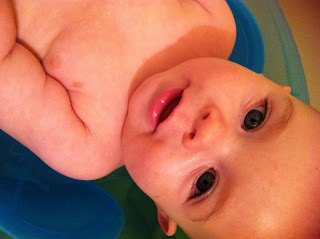Hypomelanic Macules "Ash leaf spots"
On November 30, I noticed a white spot on Grey's upper left thigh. I know the date because I keep a calendar with all the daily events and I record them for her (and us). Anyways, the spot looked like a birthmark to me. I have a port wine mark on my upper left thigh too. So I wrote on her calendar- birthmark. I took her for her 6-month well check on Monday, December 23. After her exam, I asked about her scalp (cradle cap) and the spot on her leg. Turns out, it isn't a birth mark...Before he replied, he asked, "Is that the only one?" I told him as far as we knew and it popped up a few weeks ago. He said it was there when she was born, but it is just now noticeable because pigment in her skin. Apparently, if there are a few, it is tuberous sclerosis and it is dangerous. He didn't go into detail, but he did say you don't want that. Like any curious and concerned parent, I researched "ash leaf spot" so I could learn more about what my daughter has.
This is what I found with a simple internet search on the WWW:
So now I guess I just keep an eye on her...I really don't know what to think.
This all felt sureal as Lincoln was 6-months old when he was diagnosed with mastocytosis, a rare skin condition. You can read about that here: http://rebekah-ifyoureabirdimabird.blogspot.com/2012/04/mastocytosis-urticaria-pigmentosa.html
.jpg) |
| Ash leaf spot |
Genetics
- Two genes, TS1 and TS2, carry tuberous sclerosis according to the University of Maryland Medical Center. The condition is the result of a mutation in each gene. Only one parent has to carry the gene for the condition to be inherited. A child born to one parent with the condition has a 50 percent chance of inheritance. Not every case of tuberous sclerosis is the result of an inheritance. The genes have the ability to mutate on their own and produce a new
case.(There doesn't have to be a record of family history for the gene to be passed.)
Symptoms
- Tuberous sclerosis affects the brain, skin and other parts of the body. The tumors in the brain leads to seizures. In many cases the brain does not develop fully with learning disabilities. Other symptoms include growths on the gums, tongue and eyes. Tumors also grow on the heart producing irregular heart rhythms. For skin disorders one symptom is the emergence of white spots resembling ash leafs known as ash leaf spots.
Hypomelanic Macules
- White or light patches of skin that appear on the body of persons with tuberous sclerosis are the result of a lack of melanin or skin pigment. Melanin is the substance that gives skin its color. Hypomelanic macules is the scientific name for the spots. The common name is ash leaf spots. These spots appear at any location on the body
Treatment
- In most situations ash leaf spots do not cause problems and no treatment is required. Lasers remove some skin conditions
like growths on the face that affect a person's appearance. Ash leaf spots, while affecting the skin's appearance, do not cause disfigurement for most individuals.
So now I guess I just keep an eye on her...I really don't know what to think.
This all felt sureal as Lincoln was 6-months old when he was diagnosed with mastocytosis, a rare skin condition. You can read about that here: http://rebekah-ifyoureabirdimabird.blogspot.com/2012/04/mastocytosis-urticaria-pigmentosa.html


Comments
For 39 years I always figured that God just ran out of crayon. The reading I did on the Web about it was scary. Talk of possible mental disability is not an easy thing to digest. I've always felt that I was socially retarded, but in all other aspects of my life I am doing quite well.
I would not worry, if I were you. I wear my "spots" proudly.